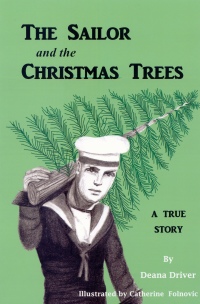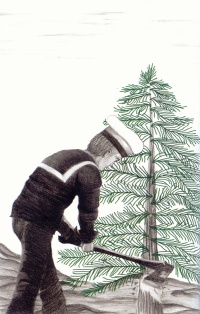| ________________
CM . . .
. Volume XIX Number 18. . . .January 11, 2013
excerpt:
Almost every day, the obituary column in my local paper records that one or more of the nation's World War II veterans is no longer with us. Fortunately, Deana Driver recorded John Hanlon's story just days before he died in Brandon, MB, on June 3, 2012. As the subtitle indicates, The Sailor and the Christmas Trees is a true story about a series of happenings that occurred in 1944 when John, then in his early twenties, was a wireless operator aboard the HMCS Royalmount, a frigate that, along with other warships, escorted convoys back and forth across the Atlantic Ocean. Realizing his ship would be at sea at Christmas, John and three fellow crew members went ashore and cut down four evergreen trees that were growing on the hills around the harbour in St. John's, NL, and then secreted them in a space in the Royalmount where they would not likely be accidentally discovered. On Christmas Day, the trees were retrieved and distributed around the ship, and the delighted crew decorated them with ornaments made on the spot from whatever was available. Now, if that was where the book ended, with the ship's crew experiencing a traditional aspect of Christmas that they hadn't expected to have in the middle of the Atlantic Ocean, The Sailor and the Christmas Trees would have been a good "warm" tale, but Hanlon's story does not end there but has two more parts. When the Captain of the Royalmount learned that one of the ships in the convoy had children aboard, he decided to surprise the children by coming along side this ship and lining one of the trees over to them. Again, this real life story could have concluded on that happy note, but, a half century later, circumstances provided closure for Hanlon when he attended a Navy reunion in Calgary. There, he encountered a woman, who, in 1944, had been one of the children aboard that ship which had received his gift of a Christmas tree.
Recommended. Dave Jenkinson, CM's editor, lives in Winnipeg, MB.
To comment
on this title or this review, send mail to cm@umanitoba.ca.
Copyright © the Manitoba Library Association. Reproduction for personal
use is permitted only if this copyright notice is maintained. Any
other reproduction is prohibited without permission.
NEXT REVIEW |
TABLE OF CONTENTS FOR THIS ISSUE
- January 11, 2013.
AUTHORS |
TITLES |
MEDIA REVIEWS |
PROFILES |
BACK ISSUES |
SEARCH |
CMARCHIVE |
HOME |

 The Sailor and the Christmas Trees is divided into two main parts, with the first being Hanlon's telling the story to his adult son and young granddaughter in response to her request, "Grandpa, can you please tell us a story?" Since Hanlon is narrating the story, he utilizes an essentially chronological approach, only interrupting the "plot" when a term needs a brief explanation. In most instances, however, readers are referred to the three-page glossary at the end of the book for further explanation of terms like "telegraph," "tiller flats" and "watch duty." The second part of the book, "About The Sailor and His Story," which begins on p. 32 and concludes on p. 42 is the "factual" part of the book which fills in some details about Hanlon's life before and after the events of his 1944 Christmas story. This section, which is accompanied by eight black and white "family-type" photos, also explains how Driver came into contact with the Christmas-at-sea story and its teller. Although younger readers may be satisfied with just the Christmas "story" portion of the book, older readers will likely also be interested in the book's story-behind-the-story section.
The Sailor and the Christmas Trees is divided into two main parts, with the first being Hanlon's telling the story to his adult son and young granddaughter in response to her request, "Grandpa, can you please tell us a story?" Since Hanlon is narrating the story, he utilizes an essentially chronological approach, only interrupting the "plot" when a term needs a brief explanation. In most instances, however, readers are referred to the three-page glossary at the end of the book for further explanation of terms like "telegraph," "tiller flats" and "watch duty." The second part of the book, "About The Sailor and His Story," which begins on p. 32 and concludes on p. 42 is the "factual" part of the book which fills in some details about Hanlon's life before and after the events of his 1944 Christmas story. This section, which is accompanied by eight black and white "family-type" photos, also explains how Driver came into contact with the Christmas-at-sea story and its teller. Although younger readers may be satisfied with just the Christmas "story" portion of the book, older readers will likely also be interested in the book's story-behind-the-story section.